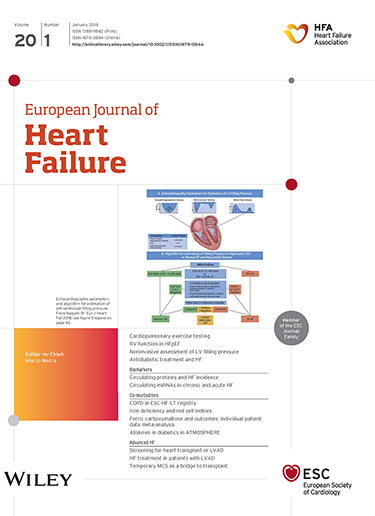癌症治疗相关的心脏毒性与心肌脂质组的明显改变有关
IF 16.9
1区 医学
Q1 CARDIAC & CARDIOVASCULAR SYSTEMS
引用次数: 0
摘要
蒽环类药物是各种化疗方案的关键成分,但其临床应用受到严重心脏毒性副作用的限制。先前的研究表明,蒽环类药物诱导的心脏毒性(AIC)可能是由心肌脂质代谢的改变驱动的。本研究旨在从潜在的病理机制和新的治疗靶点方面系统地探索AIC的心脏脂质组学景观。方法和结果对13例AIC患者(年龄53±31岁,54%为女性,左室射血分数19±4%)和15例年龄和性别匹配的对照组进行了基于质谱法的非靶向脂质组学检测。脂质组学特征也与15名其他心力衰竭病因(性别和年龄相匹配)的患者进行了比较。共分析了来自22个不同脂类的627个单个脂类。AIC与多不饱和脂肪酸向更多单不饱和侧链和饱和侧链转变的比例较低以及奇链脂肪酸比例的显著变化有关。途径分析表明,AIC中前体转化为溶脂的比例较高。这种溶脂类的积累在其他心力衰竭病因中没有观察到,可能代表了AIC的特殊发现。结论蒽环类药物引起心肌脂质组明显改变。心肌溶脂水平升高被认为是AIC中一种新的脂质组学特征,它似乎与心力衰竭的其他原因不同。进一步研究溶脂代谢的药理干预对AIC的预防和治疗是必要的。本文章由计算机程序翻译,如有差异,请以英文原文为准。
Cancer therapy‐related cardiotoxicity is associated with distinct alterations of the myocardial lipidome
AimsAnthracyclines are key components of various chemotherapy regimens, but their clinical utility is limited by severe cardiotoxic side effects. Previous studies have suggested that anthracycline‐induced cardiotoxicity (AIC ) may be driven by alterations in myocardial lipid metabolism. This study aimed to systematically explore the cardiac lipidomic landscape of AIC with regard to potential pathomechanisms and novel therapeutic targets.Methods and resultsMass spectrometry‐based untargeted lipidomics were performed on myocardial biopsies from 13 patients with AIC (age 53 ± 31 years, 54% female, left ventricular ejection fraction 19 ± 4%) and 15 age‐ and sex‐matched controls. Lipidomic profiles were also compared with 15 patients with other heart failure aetiologies (matched for sex and age). A total of 627 individual lipid species from 22 different lipid classes were analysed. AIC was associated with a lower proportion of polyunsaturated fatty acids towards more monounsaturated and saturated sidechains as well as significant alterations in the proportion of odd‐chain fatty acids. Pathway analyses indicated a higher precursor conversion into lysolipids in AIC . This accumulation of lysolipid species was not observed in other heart failure aetiologies and may represent a specific finding in AIC. ConclusionAnthracycline‐induced cardiotoxicity leads to distinct alterations of the myocardial lipidome. Increased levels of myocardial lysolipids were identified as a novel lipidomic trait in AIC , which appears to be distinct from other causes of heart failure. Further research studying pharmacological interventions in lysolipid metabolism for prevention and therapy of AIC is warranted.
求助全文
通过发布文献求助,成功后即可免费获取论文全文。
去求助
来源期刊

European Journal of Heart Failure
医学-心血管系统
CiteScore
27.30
自引率
11.50%
发文量
365
审稿时长
1 months
期刊介绍:
European Journal of Heart Failure is an international journal dedicated to advancing knowledge in the field of heart failure management. The journal publishes reviews and editorials aimed at improving understanding, prevention, investigation, and treatment of heart failure. It covers various disciplines such as molecular and cellular biology, pathology, physiology, electrophysiology, pharmacology, clinical sciences, social sciences, and population sciences. The journal welcomes submissions of manuscripts on basic, clinical, and population sciences, as well as original contributions on nursing, care of the elderly, primary care, health economics, and other related specialist fields. It is published monthly and has a readership that includes cardiologists, emergency room physicians, intensivists, internists, general physicians, cardiac nurses, diabetologists, epidemiologists, basic scientists focusing on cardiovascular research, and those working in rehabilitation. The journal is abstracted and indexed in various databases such as Academic Search, Embase, MEDLINE/PubMed, and Science Citation Index.
 求助内容:
求助内容: 应助结果提醒方式:
应助结果提醒方式:


